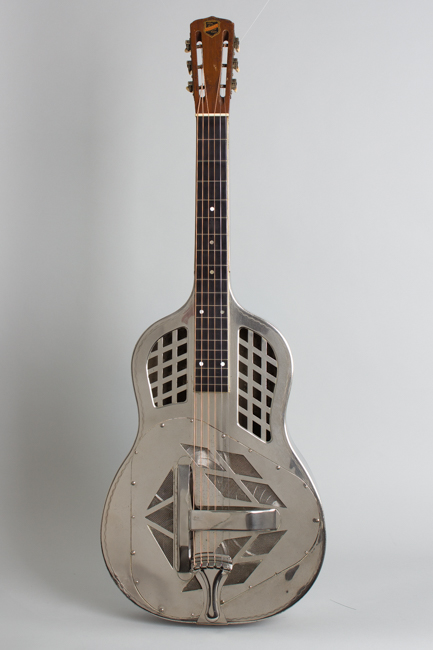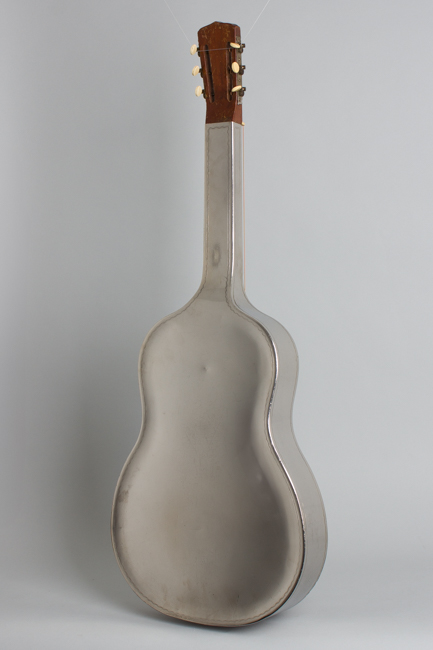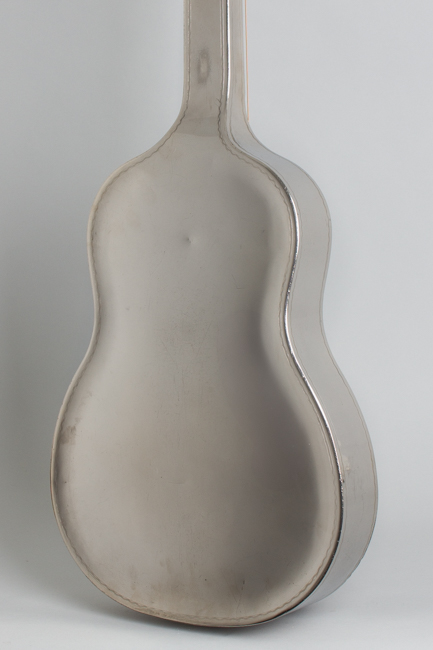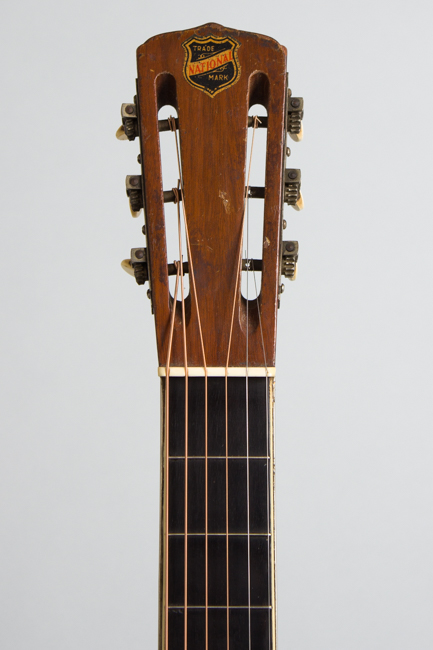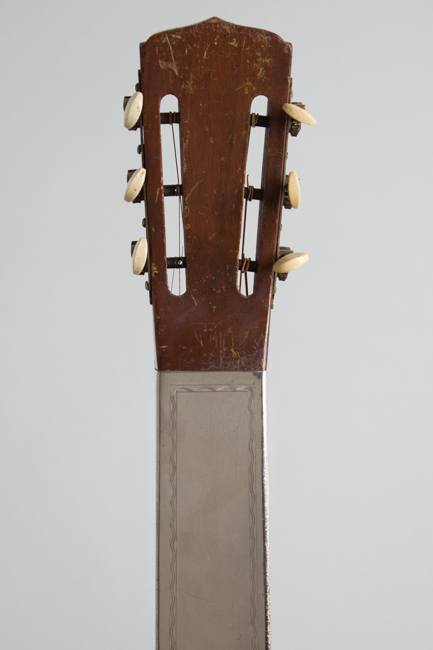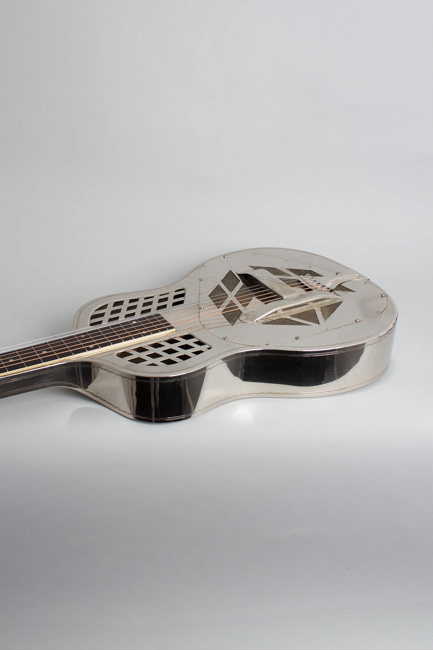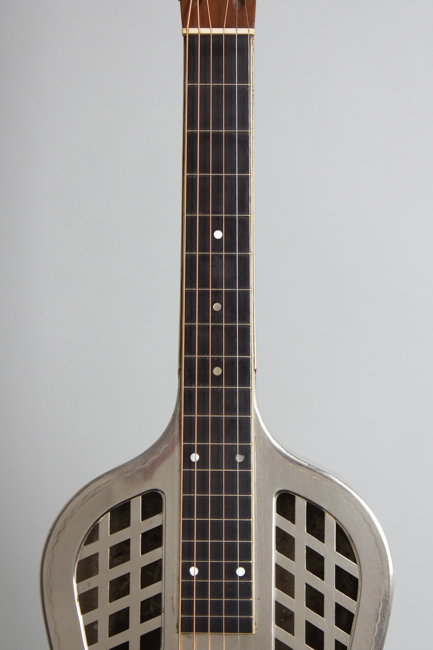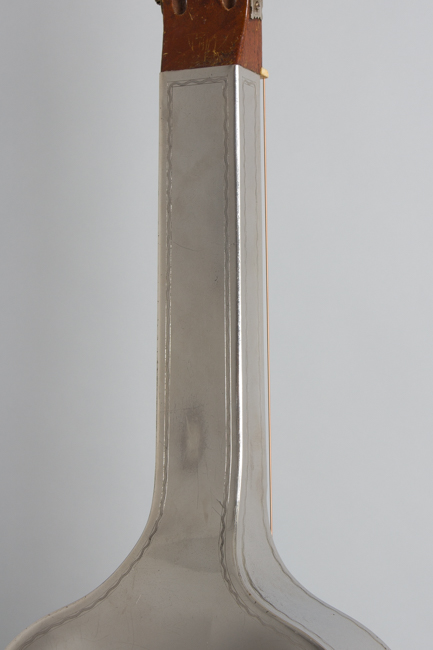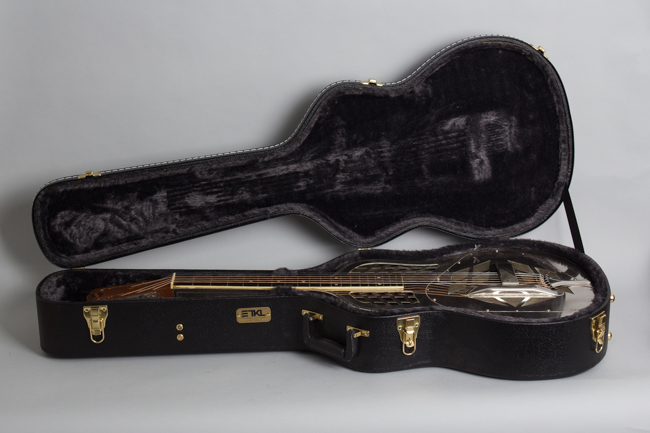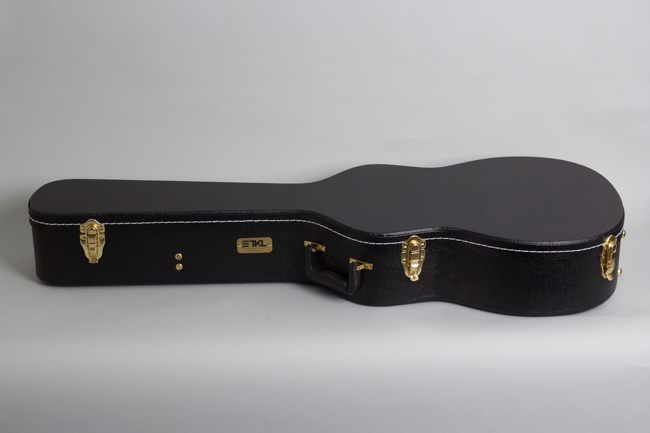National Style 1 Tricone Squareneck Resophonic Guitar (1931)
National Style 1 Tricone Squareneck Model Resophonic Guitar (1931), made in Los Angeles, California, serial # 2513, nickel plated finish, German silver body, mahogany headstock, ebony fingerboard, black tolex hard shell case.
This Style 1 Tricone is the classic Hawaiian-style National, the premier instrument of its type in 1931 -- some would say the finest ever! The National Tricone is generally considered the best-sounding of all acoustic Hawaiian guitars, and this is a nice example. Built after he 1920s Jazz Age party had come crashing down, this instrument was increasingly unaffordable as the depression kicked in but remained "state of the art" for steel playing until the advent of electrics a couple of years along the road.
The Tricone Design, as its name implies, used 3 small spun aluminum cones to amplify the strings, set inside a hollow metal body of "German silver" alloy. This mellows the attack and adds sustain, creating a uniquely ethereal sound. The Tricone was a product of a collaboration between inventor John Dopyera and Hawaiian guitarist George Beauchamp, who wanted a louder instrument for the vaudeville stage than existing wooden guitars. The project came out so well that in 1927 they attracted investors and went into production, with four styles of Tricone resonators ranging from a plain deco Style 1 with (initially) no body decoration through the elaborately engraved Style 4.
The Style 1 Tricone was the baseline model of that first line of resonator instruments made by National, the least expensive guitar the company offered from 1927-29. Even so it was still one of the priciest guitars in the world, tagged at $125, more than enough to buy a contemporary pearl-top Martin. By 1931 the National company had issued a number of lower priced single cone instruments, but the Style 1 remained the least expensive tricone. The plain Style 1 was upgraded slightly around this time with an engraved "wiggle" border added to the plain top; some collectors cell this a "Style 1 1/2" but that was never an official designation. This may have been an attempt to dress the instrument up a bit to better justify the price for the less opulent times.
The Style 1 has all the same features as the more expensive Styles 2, 3, and 4, just lacking the fancy decorative touches.
The ultra-modern resophonic guitars would continue to be built until WWII, but only in very small numbers as the great bulk of National's production from 1930 on would be the far cheaper single cone instruments, and eventually those new-fangled electrics by later in the decade.
The Tricones were forgotten for many years after, until the blues revival of the 1960s brought a new interest to the old resonator designs. The striking silver Deco look of the Style 1 is in many ways the purest form of the National concept, and looks modern even today. The guitar plays perfectly and has the smooth deep Tricone sound, fabulous for both the original Hawaiian style, blues or other 6-string steel guitar playing.
Overall length is 38 3/4 in. (98.4 cm.), 14 1/8 in. (35.9 cm.) wide at lower bout, and 3 in. (7.6 cm.) in depth at side, taken at the end block. Scale length is 25 in. (635 mm.). Width of nut is 2 in. (51 mm.).
This is a generally well preserved Square-neck Tricone with some general wear -- mostly corrosion to the plating -- and a few small dents. The cones, 3-point saddle unit, fluted tailpiece, and engraved Waverly tuners remain original; The only unusual feature is the screw array around the edge of the coverplate. Every other screw holding the plate on is oversized. As far as we can see this was done a long time ago; they are the correct style of round-head, flat bottom metal screw, just larger. While it is *possible* this was a factory expedient (some assembler ran short of screws?) we have to assume it was done later, although the body is correctly tapped for the larger thread. At any rate this does not affect the instrument in any practical way, it just looks odd.
One of the screws is additionally broken off. Apart from this the guitar seems free of repair or alteration over 90+ years. The plating has scratches and scuffing overall, with a large area worn through on the handrest and more general corrosion in that area, where the player's hands most often make contact. There are some small dents to the body on the rims and back, and a worn-through spot on the back of the neck. The fragile headstock decal has suffered some discoloration and a couple of small chips. Although not a pristine example this is still a very nice example of a "style 1 1/2" Hawaiian Tricone as we have had in some time; great-looking and fabulous-sounding. Overall Very Good + Condition.
This Style 1 Tricone is the classic Hawaiian-style National, the premier instrument of its type in 1931 -- some would say the finest ever! The National Tricone is generally considered the best-sounding of all acoustic Hawaiian guitars, and this is a nice example. Built after he 1920s Jazz Age party had come crashing down, this instrument was increasingly unaffordable as the depression kicked in but remained "state of the art" for steel playing until the advent of electrics a couple of years along the road.
The Tricone Design, as its name implies, used 3 small spun aluminum cones to amplify the strings, set inside a hollow metal body of "German silver" alloy. This mellows the attack and adds sustain, creating a uniquely ethereal sound. The Tricone was a product of a collaboration between inventor John Dopyera and Hawaiian guitarist George Beauchamp, who wanted a louder instrument for the vaudeville stage than existing wooden guitars. The project came out so well that in 1927 they attracted investors and went into production, with four styles of Tricone resonators ranging from a plain deco Style 1 with (initially) no body decoration through the elaborately engraved Style 4.
The Style 1 Tricone was the baseline model of that first line of resonator instruments made by National, the least expensive guitar the company offered from 1927-29. Even so it was still one of the priciest guitars in the world, tagged at $125, more than enough to buy a contemporary pearl-top Martin. By 1931 the National company had issued a number of lower priced single cone instruments, but the Style 1 remained the least expensive tricone. The plain Style 1 was upgraded slightly around this time with an engraved "wiggle" border added to the plain top; some collectors cell this a "Style 1 1/2" but that was never an official designation. This may have been an attempt to dress the instrument up a bit to better justify the price for the less opulent times.
The Style 1 has all the same features as the more expensive Styles 2, 3, and 4, just lacking the fancy decorative touches.
The ultra-modern resophonic guitars would continue to be built until WWII, but only in very small numbers as the great bulk of National's production from 1930 on would be the far cheaper single cone instruments, and eventually those new-fangled electrics by later in the decade.
The Tricones were forgotten for many years after, until the blues revival of the 1960s brought a new interest to the old resonator designs. The striking silver Deco look of the Style 1 is in many ways the purest form of the National concept, and looks modern even today. The guitar plays perfectly and has the smooth deep Tricone sound, fabulous for both the original Hawaiian style, blues or other 6-string steel guitar playing.
Overall length is 38 3/4 in. (98.4 cm.), 14 1/8 in. (35.9 cm.) wide at lower bout, and 3 in. (7.6 cm.) in depth at side, taken at the end block. Scale length is 25 in. (635 mm.). Width of nut is 2 in. (51 mm.).
This is a generally well preserved Square-neck Tricone with some general wear -- mostly corrosion to the plating -- and a few small dents. The cones, 3-point saddle unit, fluted tailpiece, and engraved Waverly tuners remain original; The only unusual feature is the screw array around the edge of the coverplate. Every other screw holding the plate on is oversized. As far as we can see this was done a long time ago; they are the correct style of round-head, flat bottom metal screw, just larger. While it is *possible* this was a factory expedient (some assembler ran short of screws?) we have to assume it was done later, although the body is correctly tapped for the larger thread. At any rate this does not affect the instrument in any practical way, it just looks odd.
One of the screws is additionally broken off. Apart from this the guitar seems free of repair or alteration over 90+ years. The plating has scratches and scuffing overall, with a large area worn through on the handrest and more general corrosion in that area, where the player's hands most often make contact. There are some small dents to the body on the rims and back, and a worn-through spot on the back of the neck. The fragile headstock decal has suffered some discoloration and a couple of small chips. Although not a pristine example this is still a very nice example of a "style 1 1/2" Hawaiian Tricone as we have had in some time; great-looking and fabulous-sounding. Overall Very Good + Condition.
